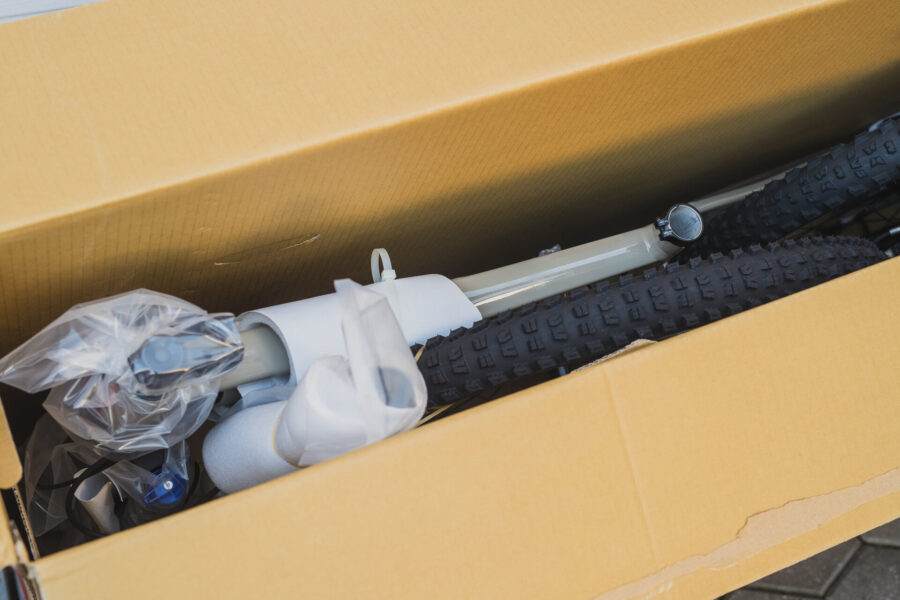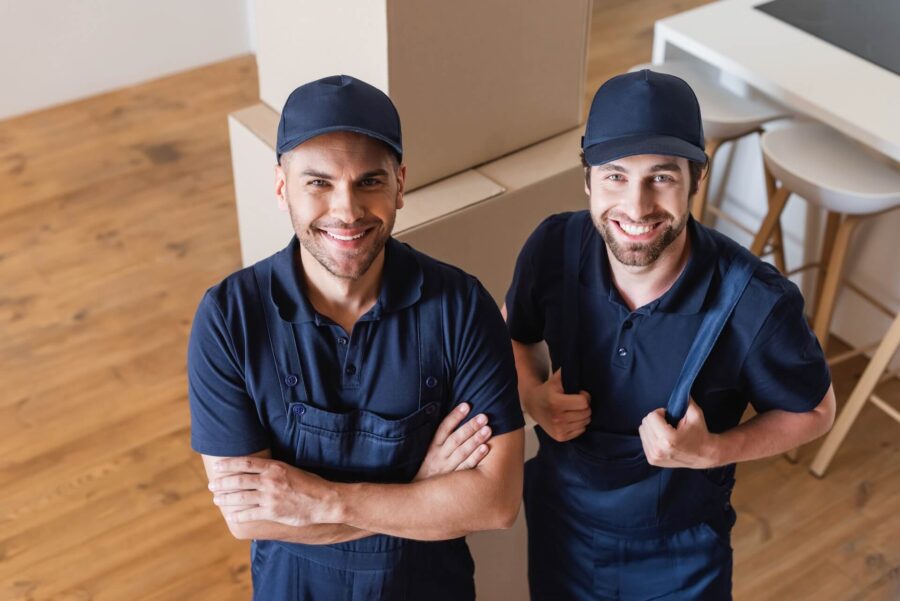Embarking on a cross-country move and wondering how to pack a bicycle for moving? Our comprehensive guide offers step-by-step instructions to ensure your bike arrives safely at your new destination. From dismantling to secure packaging, we cover everything you need to protect your bicycle during the long haul, making your move hassle-free and ensuring your bike is ready for adventures in your new locale.

How to Pack a Bicycle for Moving?
Start by cleaning the bicycle and conducting a basic maintenance check, focusing on the tires, brakes, and gears. Next, disassemble it by removing pedals, handlebars, and wheels for safer and more compact transport. Gather essential packing materials, such as a bike box or case, bubble wrap, foam padding, zip ties, and packing tape, opting for high-quality supplies for optimal protection.
For an efficient relocation, wrap each component securely and place them in your chosen container, ensuring a snug fit to prevent movement. Label the box clearly with “Fragile” and “This Side Up” to aid movers. Upon arrival, carefully unpack and inspect each part for damage before reassembling your bicycle, making sure all components are secure.
Preparing a Bike for Moving – What You Need to Know
Cross-country move with a bicycle requires proper preparation in order to avoid common relocation mistakes. This involves a thorough cleaning and maintenance check, followed by disassembly for transport. Following these relocation tips ensures your bike arrives in the best condition, ready for your next adventure.
Cleaning and Maintenance Check
Begin by cleaning to prevent dirt and grime from causing damage during shipping. Use a soft brush and mild soap to clean the frame, wheels, and components. Rinse with water and dry thoroughly. After cleaning, perform a basic maintenance check to ensure your two-wheeler is in good condition. Check the tires for proper inflation and signs of wear.
Inspect the brakes to ensure they are functioning correctly and adjust if necessary. Examine the gears for smooth operation, and lubricate the chain to prevent rust. These steps will prepare your precious two-wheeler for the relocation to a new state but also provide an opportunity to address any issues that could affect performance.
Disassembling for Safer Transport
Disassembling your bike makes it easier and safer to pack – the best way to ship a bicycle is in parts. Start by removing the pedals, which may require a pedal wrench. Turn the wrench counter-clockwise on the left pedal and clockwise on the right pedal to unscrew them. Next, adjust or remove the handlebars. If possible, simply rotate them parallel to the frame to save space. Otherwise, remove them by loosening the bolts at the stem.
Finally, remove the front wheel (and rear wheel if necessary) by opening the quick release or unscrewing the bolts. Deflate the tires slightly to reduce the risk of damage. Wrap each part in bubble wrap or protective material and secure them together to prevent movement. Label each component for easy reassembly at your destination.

Choosing the Right Packing Materials
When it comes to moving your two-wheeler safely and efficiently, the importance of choosing the right packing materials cannot be overstated. High-quality packing supplies are crucial for ensuring the utmost protection of your bike during shipping in a relocation truck. They serve to shield against potential damage from vibrations, impacts, and pressure changes.
Whether you’re relocating to a new city or a new state, equipping yourself with the right materials will give you peace of mind, knowing your bicycle is well-protected. Here’s a rundown of essential packing supplies that should be on your list:
- Bike box or case – These are the two most important bike packaging supplies. Choose one based on your budget and the level of protection required.
- Bubble wrap – Provides cushioning for the frame and delicate parts.
- Foam padding – Offers additional protection for the frame, especially around the chainrings and derailleurs.
- Zip ties – Secure loose components together, preventing movement.
- Packing tape – Ensures the box or case remains closed and secure during shipping.
Bike Boxes vs. Bike Cases
The choice between a cardboard bike box and a hardshell bike case depends on several factors, including budget, type of bicycle, and distance of the move. Bike boxes for moving are cost-effective and relatively light, making them suitable for shorter moves or less expensive bikes. However, they offer less protection against impacts.
On the other hand, hardshell cases are more durable and provide superior protection, which makes them ideal for high-value bicycles or long-distance moves. Their major drawbacks are higher cost and increased weight. Your choice should balance the level of protection required against the practical considerations of shipping.

Detailed Instructions on Packing Your Bicycle
It’s finally time to learn more about packing a bike for relocation. This process involves a careful approach to wrapping and securing each component, ensuring it’s protected throughout transit. Here’s how to achieve that, with clear instructions for coherence and ease of understanding.
Securely Wrapping Components
Begin by enveloping the frame in bubble wrap, focusing on safeguarding areas prone to damage. Ensure the bubble wrap is secured with tape that doesn’t directly adhere to the bike’s surface.
The handlebars, once aligned with the frame or removed, should also be wrapped carefully, with an emphasis on protecting the ends and levers. Applying foam padding around these and other joint areas amplifies the protection.
When it comes to the wheels, wrap them individually after removal, particularly around the rims and hubs. Slightly deflate the tires to mitigate pressure while maintaining a cushioning effect. Components like pedals and the seat should be detached and individually wrapped, ensuring each piece is accounted for and shielded. Smaller accessories can be bagged and wrapped separately to prevent loss and damage.
Packing the Bike in the Box or Case
So, how to pack a bike box? With all components securely wrapped, place the frame centrally within the box or case, using extra foam padding to buffer it against the sides. The wheels should then be positioned around the frame, ensuring no direct contact that could cause scratches or damage.
Utilize additional bubble wrap or foam to fill any voids, securing the components in place and preventing any movement that could lead to damage during transport. A light securing with zip ties or soft straps can help keep everything organized without applying pressure to any part.
Perform a final check by gently shaking the box to detect any loose movements. If necessary, add more padding to ensure everything is snug and secure. This detailed packing process ensures your bicycle will be well-protected on its journey to your new destination.

Bicycle Moving Tips for a Smooth Move
Ensuring your bicycle arrives safely at its new home requires not just careful packing but also strategic planning of relocation. Here’s how to manage the logistics effectively. Clear labeling of your packed box can significantly mitigate the risk of mishandling during shipping. Mark the box with “Fragile” and “This Side Up” indicators to alert movers to handle it with care.
Alongside physical precautions, maintaining a detailed relocation inventory of all parts packed is crucial. This inventory acts as a checklist for reassembly at your destination and safeguards against the loss of any components. Documenting the condition of your two-wheeler before packing can also serve as a reference in case any disputes arise.
Choosing the Right Moving Service
Selecting a company that has experience with bicycles and other delicate items is essential. Research and choose a long-distance moving company that offers moving services for bicycles, ensuring they understand the requirements of safe bicycle transport. One such company is our California-Seattle Express, a team of experienced movers in Seattle and California.
Before you hire movers, investigate the company’s insurance policies – comprehensive insurance coverage provides financial protection against damage or loss. Check if they’re properly licensed with FMCSA, so you can enjoy peace of mind knowing that you won’t end up a victim of a relocation scam. By focusing on these aspects, you ensure a smooth relocation, minimizing relocation stress.

Reassembling Your Bicycle After the Move
Once your two-wheeler has reached its destination, reassembling it correctly is key to getting back on the road safely. Here are some expert relocation tips for putting your bike back together and ensuring it’s ready to ride.
Unpacking and Inspection
Begin by carefully unpacking your bicycle and removing all protective materials while keeping an eye out for any signs of damage that might have occurred during transit. Inspect each component thoroughly, from the frame to the smallest accessory, to ensure everything is intact. Pay special attention to the wheels, brakes, and gears, as these are crucial for safety and performance. Document any damage you find for future reference or insurance claims.
Storage Services
Looking for storage space while you get settled? California-Seattle Express provides 30 days free storage with your move.
Car Shipping Services
We can ship your vehicles using the best freight options available. Your car will be moved safely and securely and arrive as planned.
Packing Services
Our professional packers have methods and techniques to ensure all your items are intact during and after the move.
Reassembly and Safety Checks
Follow the reverse process of your disassembly to reassemble your bike. Start with the frame, attaching the wheels, then the handlebars, pedals, and finally the seat. As you reattach each component, ensure they are securely fastened. A loose part can lead to accidents or further damage.
Once reassembled, perform a series of safety checks – test the brakes, ensure the gears shift smoothly, and check the tire pressure. Adjustments may be necessary to get everything just right. By carefully reassembling and inspecting your bike, you’ll ensure it’s not only safe to ride but also as good as it was before the move, if not better.

California-Seattle Express Is Here to Help With Your Move
Planning a relocation with movers from Seattle to California, or vice versa? The team at California-Seattle Express is here to make your transition as smooth and stress-free as possible. With years of experience in providing long-distance moving services, our cross-country moving company will ensure your belongings are transported safely and efficiently.
Our dedicated long-distance movers are committed to providing top-notch service and support every step of the way. Whether you need packing assistance or storage solutions or have specific concerns about shipping delicate items, we’re here to help. Contact us today to discuss your relocation needs and let our cross-country movers assist you in making your relocation a seamless experience.
FAQ
Can I Move My Bicycle Without Disassembling It?
Yes, you can ship your bicycle without disassembling it, but it may not be the safest option. Transporting a bike in its whole form increases the risk of damage to its parts, such as the handlebars, pedals, and wheels, especially during long-distance moves.
What if I Don't Have a Bike Box or Case?
If you don’t have a bike box or case, you can still protect your bicycle by using alternative materials. Wrap the frame and parts with bubble wrap or foam padding, secure the padding with tape, and use cardboard to create a makeshift box around it. Ensure all parts are snugly fitted and padded to prevent movement.
What Should I Do if My Bicycle Is Damaged Upon Arrival?
Document the damage immediately with photos and notes. Contact the moving company or insurance provider to report the damage as soon as possible. Most companies and insurance policies require prompt reporting for claims processing. Follow their guidance on claim submission, including providing documentation of the damage and any estimates for repairs.




